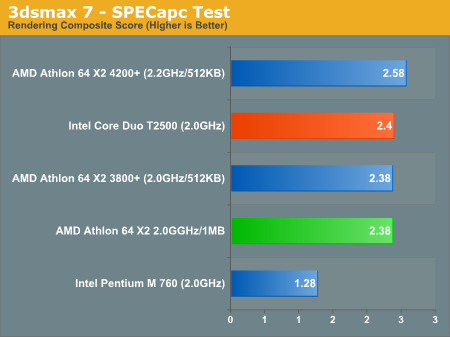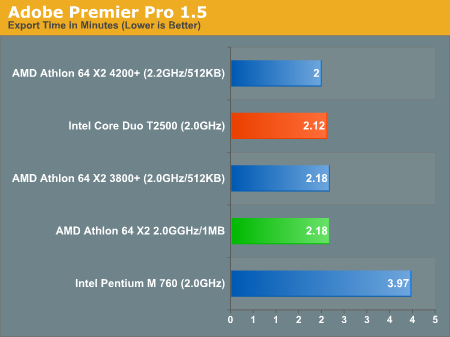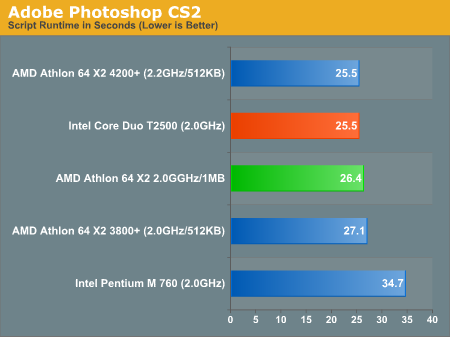Intel Core Duo (Yonah) Performance Preview - Part II
by Anand Lal Shimpi on December 19, 2005 12:55 PM EST- Posted in
- CPUs
Professional Application Performance with 3dsmax, Adobe Premier and Photoshop
We start off our page on professional application performance with an updated version of the SPECapc 3dsmax test, updated for version 7 of the application. The scenes being rendered haven't actually changed, but the reference numbers used to compute the composite scores have, so these scores aren't directly comparable to results from earlier SPECapc tests.
Compared to the Athlon 64 X2, the Core Duo comes out on top, but by a very small margin - once again we're faced with a virtual tie.
The breakdown of the rendering composite score can be found below; the scores in the table are render time in seconds, lower numbers are better:
Moving onto Adobe Premier Pro 1.5, this test is actually one that is used by Intel to showcase the performance of the Pentium 4 processor. With the Pentium 4 absent from this comparison, we were curious as to how it compared to the Core Duo and the Pentium M.
As with virtually any media encoding performance, dual-core processors do extremely well, and this case is no different with the Core Duo T2500 seriously outpacing the Pentium M 760.
The Core Duo T2500 is also able to complete the export process in about 97% of the time of the Athlon 64 X2, which once again ends up being borderline negligible for this test, but it is important to note that this advantage comes without the aid of an on-die memory controller.
Our final test is the only other Intel-supplied test in the suite. This one used to showcase the Pentium 4's performance under Adobe Photoshop CS2 by measuring the time that it takes to run a few filters and resize/export images. The script itself is fairly realistic; however, with Photoshop filters, it is easy to favor one architecture over another, so by no means are these numbers intended to be conclusive of Photoshop CS2 performance.
We start off our page on professional application performance with an updated version of the SPECapc 3dsmax test, updated for version 7 of the application. The scenes being rendered haven't actually changed, but the reference numbers used to compute the composite scores have, so these scores aren't directly comparable to results from earlier SPECapc tests.

Compared to the Athlon 64 X2, the Core Duo comes out on top, but by a very small margin - once again we're faced with a virtual tie.
The breakdown of the rendering composite score can be found below; the scores in the table are render time in seconds, lower numbers are better:
| SPECapc 3dsmax 7 Breakdown | AMD Athlon 64 X2 4200+ | AMD Athlon 64 X2 3800+ | AMD Athlon 64 X2 2.0GHz/1MB | Intel Core Duo T2500 | Intel Pentium M 760 |
| 3dsmax 5 rays | 15.406 | 15.829 | 16.109 | 14.297 | 25.246 |
| CBALLS2 | 20.125 | 22.281 | 22.094 | 21.187 | 42.201 |
| SinglePipe2 | 92.844 | 101.906 | 101.922 | 107.359 | 203.492 |
| UnderWater | 142.938 | 157.219 | 156.203 | 169.188 | 316.055 |
Moving onto Adobe Premier Pro 1.5, this test is actually one that is used by Intel to showcase the performance of the Pentium 4 processor. With the Pentium 4 absent from this comparison, we were curious as to how it compared to the Core Duo and the Pentium M.

As with virtually any media encoding performance, dual-core processors do extremely well, and this case is no different with the Core Duo T2500 seriously outpacing the Pentium M 760.
The Core Duo T2500 is also able to complete the export process in about 97% of the time of the Athlon 64 X2, which once again ends up being borderline negligible for this test, but it is important to note that this advantage comes without the aid of an on-die memory controller.
Our final test is the only other Intel-supplied test in the suite. This one used to showcase the Pentium 4's performance under Adobe Photoshop CS2 by measuring the time that it takes to run a few filters and resize/export images. The script itself is fairly realistic; however, with Photoshop filters, it is easy to favor one architecture over another, so by no means are these numbers intended to be conclusive of Photoshop CS2 performance.

Overall System Performance using WorldBench 5
Media Encoding Performance with DVD Shrink, WME, Quicktime and iTunes










103 Comments
View All Comments
Spoonbender - Monday, December 19, 2005 - link
Am I the only one recalling the old Athlon days?AMD smashes ahead with a great CPU, until around what, 2600+ or so, where they run out of steam, letting Intel overtake them.
Looks like the same might happen again...
Not sure if it's just AMD screwing up, or if it's really a question of resources.
For AMD, Athlon 64 was really a last-ditch gamble. They had to do something big, or they wouldn't exist 5 years from now.
Well, they did, and enjoyed a lot of success, but they might just not have the resources to follow up on it. Instead, their only option might be to milk the A64 for all it's worth, and then take a beating for a year or two, until they're ready with a next-gen architecture
LuxFestinus - Tuesday, December 20, 2005 - link
A question of availability needs to be raised. Are these new duo Intel processors available now? Can anyone say paper launch. How long has the dual Athlon64 been out? I thought so.Griswold - Monday, December 19, 2005 - link
I dont see where you're coming from. The A64 is a K7 on steroids. The P-M is a P3 on steroids and Conroe will also just be a P-M on steroids. Both companies didnt come up with flashy, brandnew architectures over the last few years, they only added flashy things to existing designs. Here and now, it's still Intel playing the catchup game until we see Conroe in stores. And then you always have to keep in mind that AMD is yet to move to 65nm. It will certainly give them some more clockspeed headroom.I agree with the conclusion of the article, we'll see a neck to neck race in a year from now where the better price will make the difference. AMD really doesnt have to flex its muscles now, they can milk the crowd with a superior product - and people will pay whatever to get it, or so it seems.
Calin - Tuesday, December 20, 2005 - link
Several of the flashy brand new architectures of the last few years had any kind of success. Itanium/EPIC, Transmeta, Netburst... As long as Transmeta was supported by a company with very little financial power (so their loss was somewhat expected), Itanium is crawling ahead on life support, and Netburst (while being king of the hill for a good time) will be discontinued.Griswold - Tuesday, December 20, 2005 - link
The point is: Netburst is certainly a design that could be considered newer or more radical compared to the P3->P-M->Yonah/Conroe/Merom route. In the end netburst was still a technical failure, but certainly not a financial mistake.Well and Epic, thats much older than you think. But yes, it never ended up where Intel wanted it to be: on the desktop.
allies - Monday, December 19, 2005 - link
It seems like with Intel's new chips, we're going to be back to a point where neither company has a true lead on the other. AMD is in great position at the moment, but they need to get their Turion X2 out to combat Intel's Centrino Duo. Otherwise, they'll find themselves losing laptop sales, an area which they've come a ways in.Right now, although clockspeed isn't increasing as fast as it once was, is a very exciting time for computer technologies. Parallelism, die shrinking, heat reduction, among other strides are paving the way to the future.
ncage - Monday, December 19, 2005 - link
Are you sure the improvements in games are due to the different Memory Controller technoliges? Are you sure its not the FPU?tfranzese - Monday, December 19, 2005 - link
I was thinking the same, considering his thoughts are pure speculation on his part. So, until Anand can provide data to back that up, he should stick to commending AMD's architecture rather than trying to credit all their success to the on-die memory controller (which surely helps, but it's only one part in the formula).I would doubt AMD is sitting idle though, and as they work on their next architecture will keep their lips sealed in order to maintain an element of surprise. Surprise like when they added SSE support to the Palomino and SSE3 support to Venice - both unexpected additions.
Furen - Monday, December 19, 2005 - link
The K8s execution core is pretty much the same as the K7s. If you compare performance (in games) between the two you'll notice that the K8 performs much better. This is due to the fact that it removes the FSB bottleneck (by integrating the memory controller), increases the width of the L2 cache (and the size) and dramatically drops the memory access latency. Sure there are other minor differences but they're mostly minor improvements, like better branch prediction, etc.tfranzese - Monday, December 19, 2005 - link
I don't see where the two of you are going with this and only serve my point that pinning the successes of the architecture on the memory controller is only speculation.